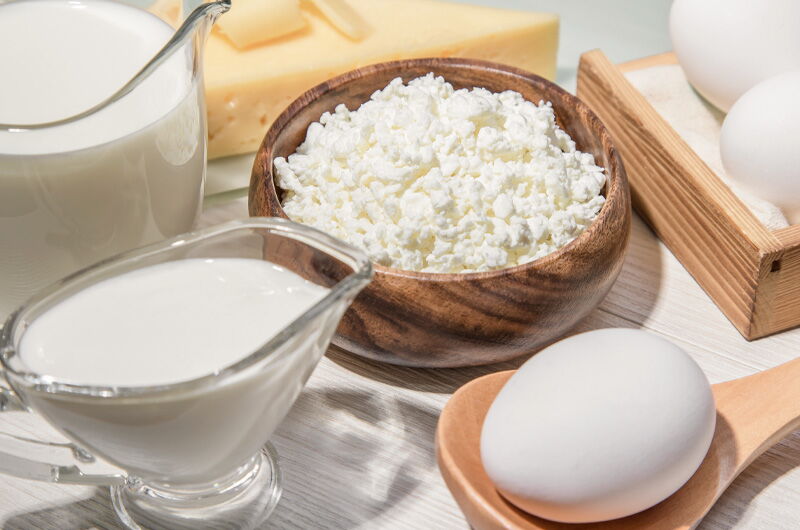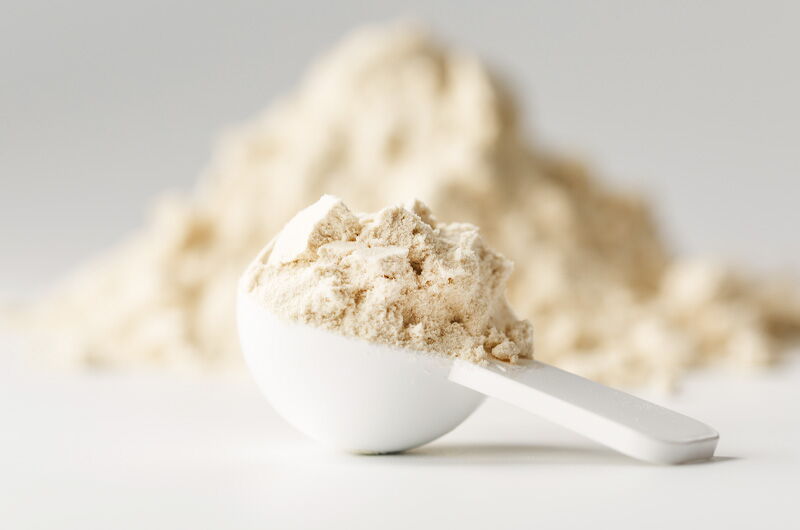Among the supplements most used by those who practice bodybuilding or attend the gym in general we certainly find the caseins, a particular class of peptides (Protein) known for their content of proteinogenic amino acids, therefore able to increase muscle mass and protect it after exertion. In this article we will discover together what they are, what they are for and how to integrate this specific class of molecules.

What are caseins and where do we find them?
Caseins are a family of phosphoproteins which in cow's milk represent about eighty percent of total Protein, of which the remaining 20% is represented by whey Protein and enzymes. Within this family of Protein we find different types of casein, in this case there are Caseins α, β, γ, and k. The different types of caseins are not present in equal quantities: in fact, 38% of them are represented by α s1 and α s2, 10% from β, a further 36% from γ and the remaining 13% from k. Thanks to their chemical-physical properties, these Protein are able to form aggregates, the sub-micelles, which uniting together give rise to larger structures, which are simply called micelles. This is the reason for the name of “micellar caseins”, a term that is often used to indicate this class of molecules. These peculiar structures are very finely dispersed in the milk and they represent the key to the cheese making process. By lowering the pH, in fact, which can be obtained through the use of acids or with rennet, it is possible to cause the union of several micelles which precipitate and separate from the liquid phase, giving rise to the first phase of cheese production. . The fine dispersion of the micelles, together with the emulsion of the fat globules, are also the reason why the milk appears white. These are in fact able to deflect the light that passes through it and therefore confer the white color. Casein micelles can also be separated from milk by means of filtration processes that make it possible to obtain powders with a very high casein content.
From the point of view of composition, caseins have an average biological value of 70 and contain all 9 essential amino acids (EAA), with a leucine content lower than that contained in whey Protein, and a level of proline of about 16%. Casein, rich in EAA in quantities similar to those present in human Protein, is considered to have a high biological value (BV) despite the lower concentration of leucine. All the types of caseins listed above show a similar and for the most part almost overlapping amino acid profile.

In addition to milk and derivatives (such as yogurt and other fermented milks, Grana Padano, Parmigiano Reggiano) we can also find it in many industrially produced foods (such as toppings, sweets or creams) that may contain varieties of caseinate, which is used as a stabilizing food additive.
Use of caseins as part of training and before sleep
As noted above, caseins are high quality Protein that make it possible to meet the daily amino acid requirement and can be used to reach the desired protein quota. These Protein are defined as " slow Protein ", because thanks to their ability to form a gel in the stomach it takes a long and prolonged time for them to be completely digested. The slowing of gastric emptying is considered to be the main cause of the lowering of the perception of hunger following the intake of caseins.
Caseins are often used as a " pre-bed " meal, which is the last meal eaten before bedtime. This mode of intake is due to the fact that the peculiar structure of these Protein makes digestion slower, and allows a prolonged release of amino acids into the blood stream. The ability to guarantee an anabolic state during the hours of sleep is attributed to this characteristic. Although some studies have confirmed that consuming casein before bed is able to increase protein synthesis during the night and facilitate recovery following an intense training session, others have focused attention on whether it is the total daily protein intake is of greater importance and that the consumption of casein must always be contextualized in order to achieve this intake. Regarding the effect of caseins on appetite and basal metabolism in the day immediately following the meal taken before bedtime, no significant differences seem to have been identified.
But how much casein to consume?
To this question, as always, one must put one's protein requirement and in general the protein level of the diet first. Without knowing these two parameters it is almost impossible to establish an ideal quantity, because the protein requirement is subjective, and is influenced by age, growth, pregnancy, breastfeeding, level of muscle mass, any pathologies and even levels of motor activity.
And when to consume it?
It depends on the purpose of the hiring. If we only need it to reach protein needs, it can be taken at any time of the day. If, on the other hand, we are strength athletes or bodybuilders, by choosing to integrate it in the pre-workout, protein synthesis can benefit from it, becoming more efficient. Before going to sleep, ensure a continuous, slow-release AA intake during the night (although there is no evidence to support the risk of muscle catabolism due to overnight fasting).

In summary, and based on what has been observed, caseins represent a valid choice to reach the individual daily protein quota necessary to reach one's needs, and also the slowing mechanism of gastric emptying which results in the reduction of the sensation of hunger and the increased protein synthesis during the night hours are very interesting factors. However, these must be contextualized within the totality of the diet and integrated into the strategy established with the healthcare professional.
Bibliography:
Food chemistry; P. Cabras, A. Martelli; Piccin
Principles of food chemistry; P. Cappelli, V. Vannucci; Zanichelli
THE BIOLOGICAL VALUE OF Protein AT DIFFERENT LEVELS OF INTAKE. BY H. H. MITCHELL. (From the Department of Animal Husbandry, University of Illinois, Urhanca.)
Auestad N, Layman DK. Dairy bioactive Protein and peptides: a narrative review. Nutr Rev. 2021 Dec 8;79(Suppl 2):36-47. doi: 10.1093/nutrit/nuab097. PMID: 34879145; PMCID: PMC8653944.
Jäger R, Kerksick CM, Campbell BI, Cribb PJ, Wells SD, Skwiat TM, Purpura M, Ziegenfuss TN, Ferrando AA, Arent SM, Smith-Ryan AE, Stout JR, Arciero PJ, Ormsbee MJ, Taylor LW, Wilborn CD, Kalman DS, Kreider RB, Willoughby DS, Hoffman JR, Krzykowski JL, Antonio J. International Society of Sports Nutrition Position
chattinger CM, Leonard JT, Pappas CL, Ormsbee MJ, Panton LB. The effects of pre-sleep consumption of casein protein on next-morning measures of RMR and appetite compared between sedentary pre- and postmenopausal women. Br J Nutr. 2021 Jan 28;125(2):121-128. doi: 10.1017/S0007114520001506. Epub 2020 May 4. PMID: 32364091.
Dela Cruz J, Kahan D. Pre-Sleep Casein Supplementation, Metabolism, and Appetite: A Systematic Review. Nutrients. 2021 May 30;13(6):1872. doi: 10.3390/nu13061872. PMID: 34070862; PMCID: PMC8229753.
Stand: protein and exercise. J Int Soc Sports Nutr. 2017 Jun 20;14:20. doi: 10.1186/s12970-017-0177-8. PMID: 28642676; PMCID: PMC5477153.
Reis CEG, Loureiro LMR, Roschel H, da Costa THM. Effects of pre-sleep protein consumption on muscle-related outcomes - A systematic review. J Sci Med Sport. 2021 Feb;24(2):177-182. doi: 10.1016/j.jsams.2020.07.016. Epub 2020 Aug 7. PMID: 32811763.
Lorenzen J, Frederiksen R, Hoppe C, Hvid R, Astrup A. The effect of milk Protein on appetite regulation and diet-induced thermogenesis. Eur J Clin Nutr. 2012 May;66(5):622-7. doi: 10.1038/ejcn.2011.221. Epub 2012 Jan 25. PMID: 22274550.
